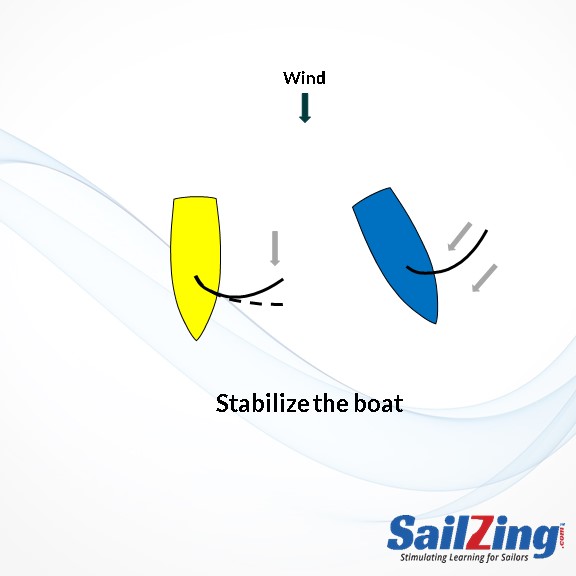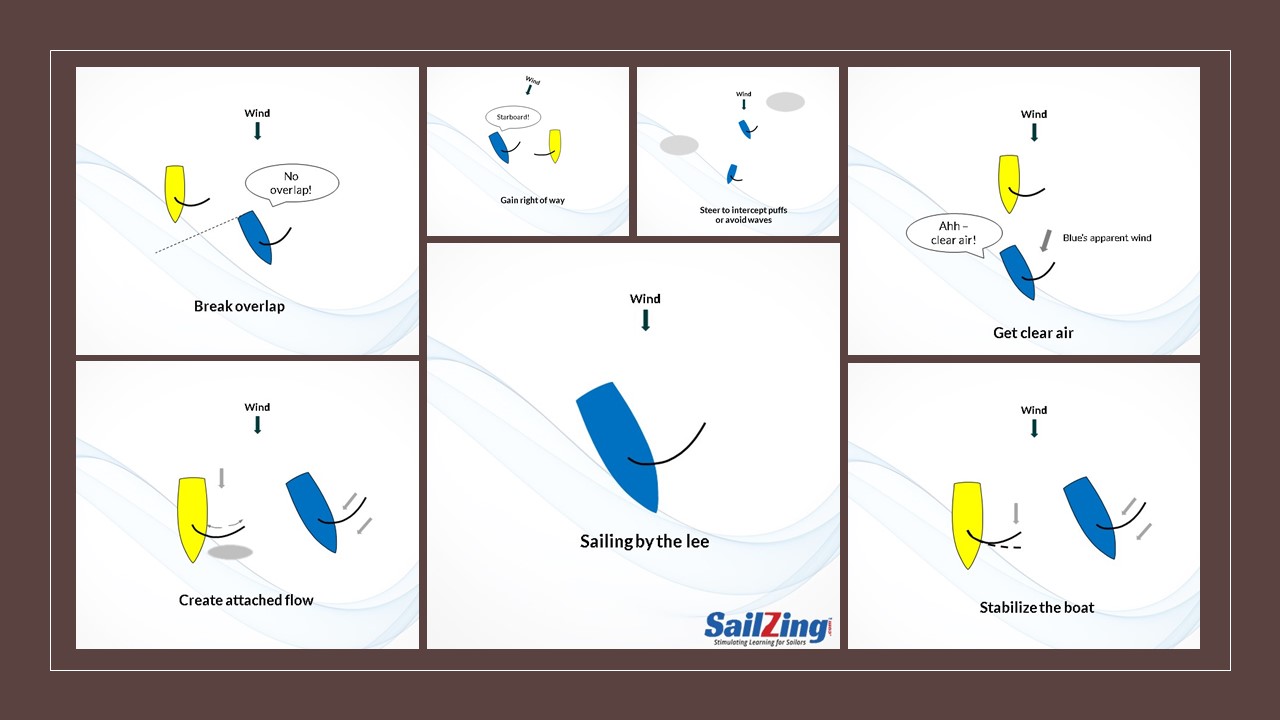We’ve had several newer sailors ask us about sailing by the lee. This is not a well-understood topic, especially for those that haven’t raced seriously in cat-rigged (single sail) boats. For this post, we collected the available wisdom on sailing by the lee.
Our sources include the following:
Optimist Racing, by Phil Slater and Steve Irish
Improper Course, a Laser sailing blog by Doug Peckover
Videos from the International Sailing Academy
Articles from the Rooster Sailing Blog by Steve Cockerill
What is sailing by the lee?
We’ve seen several definitions. The most succinct is from L-36.com’s sailing terms:
“Sailing downwind with the wind blowing over the leeward side of the boat.”
L-36.com

Think of sailing by the lee as “bearing off past dead downwind.” The shroud telltales will point away from the mast. If you bear off far enough, the leech ribbons and sail telltales will show reversed flow as the wind flows over the sail from leech to luff.
Does it work in all boats?
By the lee works best on cat-rigged boats, such Optis, Lasers, Butterflies, MC/C Scows. The technique is fundamental in boats with unstayed masts (Optis, Lasers, Butterflies), but it also works with stayed masts.
By the lee is not very effective in sloop-rigged boats (boats with main and jib/spinnaker), since the main sail shadows or disturbs the wind for the jib or spinnaker.
Why is it beneficial?
Sailing by the lee lets you steer past dead downwind without gybing to navigate waves, intercept puffs, get clear air, or gain a tactical advantage. In some situations, by the lee is also faster and more stable than dead downwind. Let’s explore each of these benefits.
Intercept puffs or navigate waves

“Connecting the dots” by steering from puff to puff is a crucial downwind technique. Rather than gybing for nearby puffs to leeward, sail down to them.
In waves, you’re steering either to surf or to aim for the flat spots to avoid burying the bow. Either way, if you can only head up to navigate waves, you’ll soon sail off the course. Sailing by the lee as needed is the only practical technique.
Get clear air

Sailing dead downwind puts you in the wind shadow of boats directly behind. In the situation shown, the boat being shadowed could sail by the lee, so that her apparent wind shifts to leeward.
Gain a tactical advantage
Here are two ways. There are probably more:

Stay on starboard tack for much of the run. If you sail by the lee rather than gybing in the smaller shifts, you can stay on starboard tack, giving you right of way over boats that gybed to port. This is especially important if you need to sail lower to round the mark, but don’t want to gybe to port.

Break overlap. To avoid giving room to boats close behind, you can break an overlap by bearing off by the lee before entering the zone.
Stabilize the boat

In Explaining The 4th Dimension, Steve Cockerill explains why sailing by the lee is more stable than dead downwind in a big breeze, especially when you’re steering to avoid waves. Here are the key points:
- Dead downwind in a breeze is “wobbly.” Wind gusts push the leech out past the mast and the boat heels up. Then the gust diminishes and the boat flattens out. This oscillation can be become uncontrollable, especially if the skipper steers the wrong way in response.
- Dead downwind with lots of vang is inflexible. Adding vang tightens the leech, but makes the boat harder to steer. If you steer up to avoid a wave with a tight leech, you’ll catch the boom in the water. Leech tension generates weather helm when you try to steer down.
- By the lee fixes the wobblies and lets you steer.
- With reverse flow over the sail, gusts don’t affect the leech position as much, since the wind is flowing over the sail, rather pushing on it.
- With less load on the leech, you can reduce vang tension, making the sail fuller and the boat easier to steer.
- The ability to steer also helps keep the boat balanced. If the boat rolls up to windward, pull the tiller to windward. The water impinging on the deflected rudder will bring the reduce the rolling. If the boat rolls to leeward, push the tiller to leeward.
Sail faster (potentially)

In our post Sail Faster Downwind: In Pressure and by the Lee, we summarized articles from Doug Peckover explaining why sailing by the lee is potentially faster. The theory makes sense: when running straight downwind, you get no lift from air flowing across the sail. By the lee, you’re getting flow over the sail that potentially allows you to go faster than the wind.
Few sailors have mastered sailing by the lee to gain speed, and it may not work for you or your class of boat. The good news is that you won’t likely lose speed sailing by the lee, so you can reap the other benefits without worrying about going slower.
Video examples
Here’s a nice video from the International Sailing Academy that explains some of the benefits of sailing by the lee.
Here’s a video of Tom Slingsby sailing downwind in a Laser. Note two techniques:
- Aggressively heading up and then sailing past downwind to navigate waves
- Sailing downwind with the sail trimmed in to get reverse flow for more speed.
How to sail by the lee
- Let sail out to 90 degrees or to the sidestays.
- With an unstayed mast, avoid going past 90 degrees in heavy air. The boat will get very unstable.
- Reduce vang tension to let top of sail twist off some as you steer past dead downwind.
- Getting vang tension right is crucial in big breeze.
- Too little tension and the boat will be unstable.
- Too much and a puff will quickly capsize you.
- The leech should be able to move back and forth over a narrow range (maybe eight inches in a Laser, according to Peckover) to respond to changes in the wind.
- Reducing vang tension also helps you get reverse heel on the boat to counteract weather helm.
- Avoid a gybe by watching for a flicker in the leech to limit how much you steer past dead downwind.
- Getting vang tension right is crucial in big breeze.
- When you want to head back up, you may have to increase vang tension to keep the boat stable.
- Experiment with getting more reverse flow to go faster.
- Either head down more or trim in some to increase reverse flow.
- Peckover says you will feel an increase in mainsheet tension when the reverse flow creates lift.
- If you sense that the boat is slowing, head back up and try again after a bit.
Rules Impact
Does sailing by the lee affect the definition of windward and leeward? Which boat below is the leeward boat?

Answer: Blue is the leeward boat. We’re used to thinking of windward as the side from which the wind is coming. However, the rules definitions of windward and leeward clear this up, by stating that “when sailing by the lee or directly downwind, [a boat’s] leeward side is the side on which her mainsail lies.”
Downwind Trimming Strategies for Upper Leech Twist
How To Set Your Vang Downwind – YouTube


